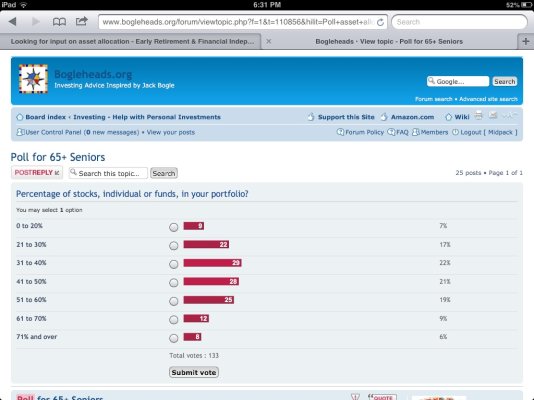ER Eddie
Thinks s/he gets paid by the post
- Joined
- Mar 16, 2013
- Messages
- 1,788
I'm fairly new to investment. Currently my money is in three Vanguard funds: Target Retirement 2015, Life Strategy Moderate Growth and Wellington funds. As I've been learning more, I have seen a number of shortcomings in my current setup.
To make a long story short, I'm thinking about shifting everything to the asset allocation below. But, since I'm still pretty new at this, I thought it would be a good idea to check it out with the forum first, before I went ahead.
For context, I am 51 years old, and I plan to shift from full-time to part-time work in about one year. I will continue working part-time as long as I enjoy it. As far as risk tolerance goes, I am probably in the moderate or perhaps low-moderate range.
Anyhow, here is the allocation I'm thinking about. Tell me if this seems reasonable:
All funds purchased through Vanguard.
60% stocks, 40% bonds.
Of the stocks, 70% would be in US funds, 30% in international.
Of the US stocks:
- 60% in Vanguard 500 Index fund
- 20% in Mid-cap Index fund
- 20% in Small-cap Value fund
Of the international stocks:
- 75% in Developed Markets Index fund
- 25% in Emerging Markets Index fund
Of the bonds:
- 50% Short-term Index Bond fund
- 50% Intermediate Term Index Bond fund
Does that seem about right? Is there anything significant that I am overlooking?
Thanks in advance for any input.
To make a long story short, I'm thinking about shifting everything to the asset allocation below. But, since I'm still pretty new at this, I thought it would be a good idea to check it out with the forum first, before I went ahead.
For context, I am 51 years old, and I plan to shift from full-time to part-time work in about one year. I will continue working part-time as long as I enjoy it. As far as risk tolerance goes, I am probably in the moderate or perhaps low-moderate range.
Anyhow, here is the allocation I'm thinking about. Tell me if this seems reasonable:
All funds purchased through Vanguard.
60% stocks, 40% bonds.
Of the stocks, 70% would be in US funds, 30% in international.
Of the US stocks:
- 60% in Vanguard 500 Index fund
- 20% in Mid-cap Index fund
- 20% in Small-cap Value fund
Of the international stocks:
- 75% in Developed Markets Index fund
- 25% in Emerging Markets Index fund
Of the bonds:
- 50% Short-term Index Bond fund
- 50% Intermediate Term Index Bond fund
Does that seem about right? Is there anything significant that I am overlooking?
Thanks in advance for any input.
Last edited:


